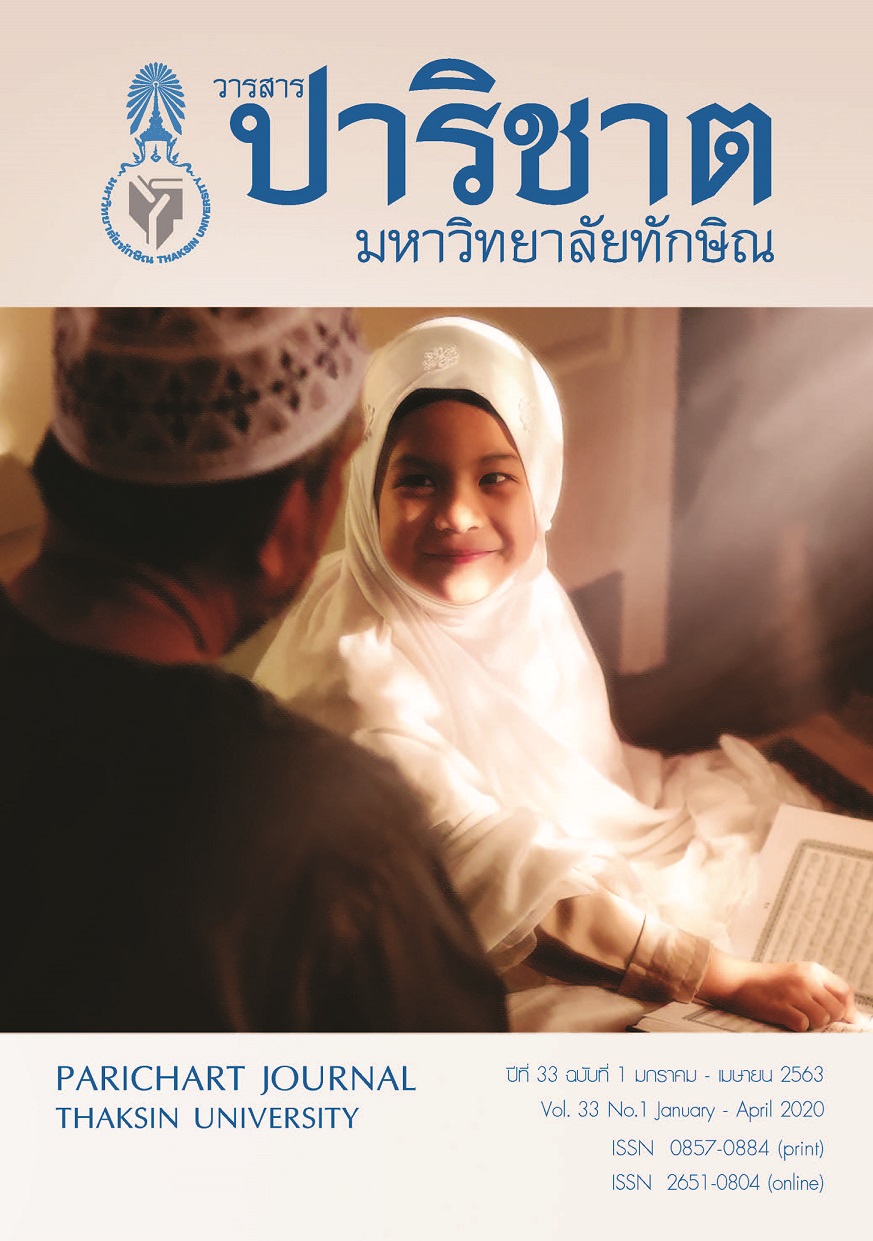Factors Related to Dressing Behavior Imitating Korean Entertainment Media among Undergraduate Students of a Faculty in Prince of Songkla University
Main Article Content
Abstract
This study was to investigate factors related to dressing behavior imitating Korean
enterta i nment media among undergraduate students of a faculty at Prince of Songkla University. The data were collected from 200 subjects, and data were analyzed using R Program to calculate Pearson’s Product Moment Correlation Coefficients and Linear Multiple Regression. The results of the study revealed three predictors of dressing behavior imitating Korean entertainment meadia among undergraduate students of a faculty at Prince of Songkla University with predictability at a significance level of .001 and .05, which included media receiving frequency (X2), attitude towards dressing behavior imitating Korean entertainment meadia (X4), and motivation in dressing behavior imitating Korean entertainment meadia (X5). Motivation in dressing behavior imitating Korean entertainment meadia (X5) had the highest level of relationship, and media receiving frequency (X2) was the lowest.
Article Details
References
Bateson, G., & Ruesch, J. (1951). Communication: the social matrix of psychiatry. New York:W. W. Norton & Co.
Sirasunthon, N. (2002). Nude pop culture. Bangkok: Nation. (In Thai)
Sakultongaram, T., Katawe, A. & Baitong, W. (2017). Motivation in learning korean language: The case study of korean language major students at university of the thai chamber of commerce, thailand. In The 2nd UTCC National Academic Conference. 1599-1612. June 8, 2018. Bangkok: University of the Thai Chamber of Commerce. (In Thai)
Malikhaw, P. (2011). Factors affecting to the purchasing behavior of female fashion clothing through facebook. Master’s Thesis. Bangkok: Rajamangala University of Technology Thanyaburi. (In Thai)
Loatrakul, P. (2001). Mental health care guide for school age children for health center handbook. Bangkok: Department of Mental Health. (In Thai)
Lindeman, R. H., Merenda, P. F. & Gold, R. Z. (1980). Introduction to bivariate and multivariate analysis. United States: Scott Foresman.
Cronbach, L. J. (1951). Coefficient alpha and the internal structure of tests. Psychometrika, 16(3), 297-334.
Morgan, L. H. (1877). Ancient society. Chicago: Charles H. Kerr & Company.
Aumpipat, E. (1997). The behavior modification. Bangkok: Rajanukul Institute. (In Thai)
Ministry of Culture. (2019). The promoting of thai identity and Thainess. Retrieved on 3 August, 2019, from https://www.m-culture.go.th.
Boon, S. D. & Lomore, C. D. (2002, January-February). Fan club confessions: teens underestimate influence of celebrity idols. Psychology Today, 18, 122.
Buck, W. R. (1991). Modes of continental lithospheric extension. Journal of Geophysical Research. 96, 20161-20178.
Chaiprapa, W. (2011). The influence of korean entertainment media following to dressing behavior among undergraduate students in Prince of Songkla University. Master’s Thesis. Songkhla: Prince of Songkla University. (In Thai)
Klapper, T. J. (1960). Effects of mass communication. United States: Free Press.
Schramm, W. L. (1973). Channel and audience in handbook of communication. Chicago: Renelly College Publishing Company.
Kaewthep, K. (2017). Utilization of research in participatory cultural management services. Bangkok: The Thailand Research Fund. (In Thai)
Eadie, W. F. (1987). 21st century communication: A reference handbook. United Kingdom: SAGE.
Mcleod, J. M. & O’Keefe, G. J. (1972). The socialization perspective and communication behavior. In current perspective in mass communication research. 123. London: SAGE.
Inthachot, N. (2008). South korean tv dramas and attitude and behavior of high school students in bangkok metropolis. Nontaburi: Sukhothai Thammathirat University. (In Thai)
Chaleemui, T. (2016). The relative between media exposure and the imitation behavior of Thai teenage in culture effect on hormones the series season 3. Master’s Thesis. Bangkok: Bangkok University. (In Thai)


